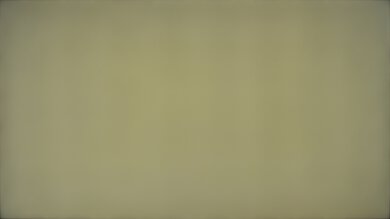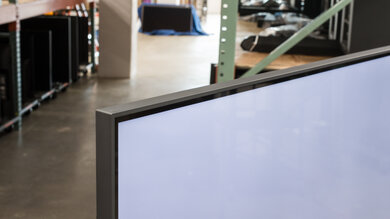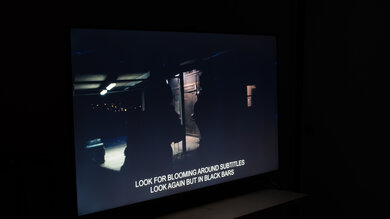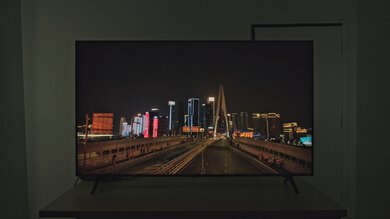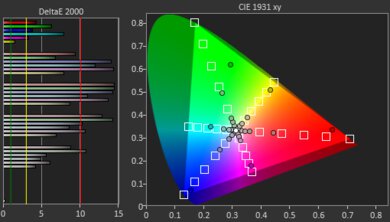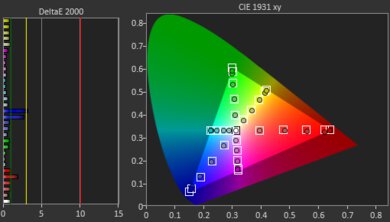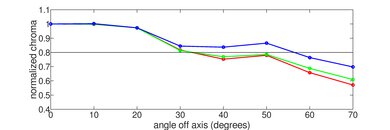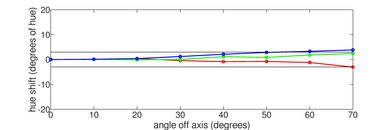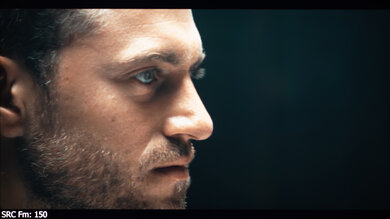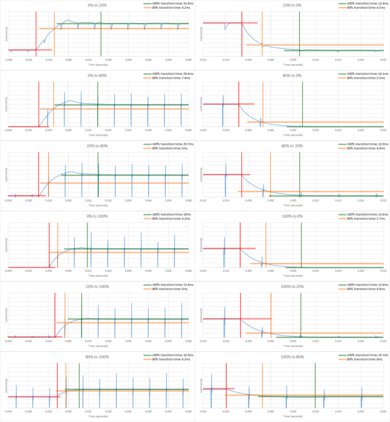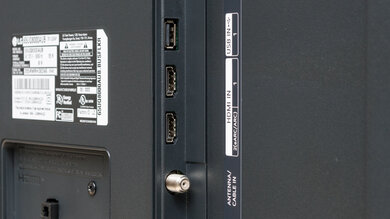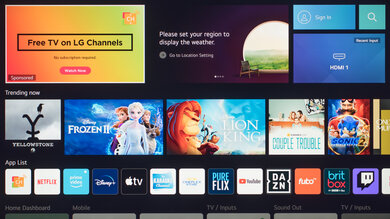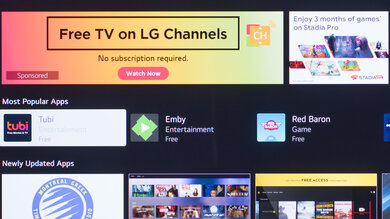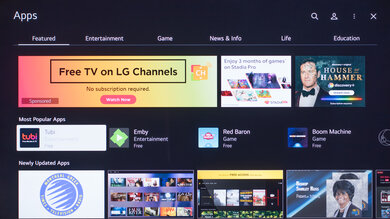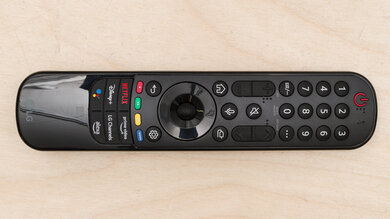The LG UQ8000 is an entry-level TV in LG's 2022 lineup. It sits between the LG UQ9000 and the LG UQ7590, and like their other entry-level models, it's limited in extra features. It comes with the same user-friendly LG webOS smart platform and the intuitive Magic Remote, whose point-and-press feature you can use to easily navigate the interface. It's available in several sizes, from 43 to 86 inches, and while most have basic features, the 86-inch version comes with extra gaming perks that the smaller sizes don't have, like HDMI 2.1 bandwidth and variable refresh rate (VRR). It's available internationally at several retailers, but in the United States, you can only get it at warehouse retailers like Sam's Club, Costco, and BJ's. It's been replaced in 2023 by the LG UR8000.
Our Verdict
The LG UQ8000 is an okay TV for mixed usage. It's best suited for use as a PC monitor or for watching shows in a moderately lit room since it has decent reflection handling but doesn't get bright enough to overcome glare from brighter light sources. It's decent for watching sports thanks to its wide viewing angle, which means you can watch the game with friends, and everyone will get to watch a consistent image. Unfortunately, the TV has a slower response time, so there's noticeable blur and image duplication behind quick-moving objects. It's mediocre for watching movies in dark rooms as blacks look gray, and the TV lacks a local dimming feature to further improve the contrast.
- Wide viewing angle.
- Decent reflection handling.
- Low contrast ratio.
- Some uniformity issues.
- Low peak brightness.
The LG UQ8000 is satisfactory for watching TV shows. It has decent reflection handling but doesn't get bright enough to fight a lot of glare, so it's best suited for a moderately-lit room. Its wide viewing angle makes it ideal for wide seating arrangements or if you move around your room while watching TV. It does a good job when upscaling lower-resolution content, and if you stream your shows, it has an excellent smart interface with a ton of apps available to download.
- Wide viewing angle.
- Decent reflection handling.
- Some uniformity issues.
- Low peak brightness.
The LG UQ8000 is okay for watching sports. Its wide viewing angle makes it a great choice for watching the game with a large group of friends because the image remains consistent from the sides. It adequately upscales lower-resolution content, which is important if you watch sports from a cable box. Unfortunately, its motion handling is mediocre, as it has image duplications. It isn't ideal for well-lit rooms due to its low peak brightness, and there are noticeable vertical bands when watching sports like hockey that have large uniform areas of the same color.
- Wide viewing angle.
- Decent reflection handling.
- Some uniformity issues.
- Low peak brightness.
- Image duplication with fast-moving content.
The LG UQ8000 is mediocre for gaming. It has remarkably low input lag that delivers a responsive gaming experience. Unfortunately, it lacks modern gaming features and only has a 60Hz refresh rate and HDMI 2.0 bandwidth, so you can't take full advantage of the latest gaming consoles. It also has a slower response time, and there's image duplication with fast-moving images that's distracting. Finally, it has a very bad contrast ratio that makes blacks look gray in the dark.
- Low input lag.
- Low contrast ratio.
- Low peak brightness.
- Image duplication with fast-moving content.
- No modern gaming features.
The LG UQ8000 is mediocre for watching movies. Since the TV lacks a local dimming feature and has a very bad native contrast ratio, blacks look gray in the dark. It has poor HDR peak brightness and doesn't support a wide color gamut, so highlights don't pop as they should, and colors aren't vibrant with HDR content. The TV also doesn't support the more advanced HDR10+ or Dolby Vision HDR formats, so it can't take full advantage of a lot of HDR content. It does have good low-quality content smoothing, so movies from streaming platforms are mostly free of compression artifacts.
- Removes 24p judder from any source.
- Fantastic color accuracy nearly out-of-the-box.
- Low contrast ratio.
- Low peak brightness.
- Limited color gamut.
The LG UQ8000 is okay for HDR gaming. It has remarkably low input lag, so there's no delay between your controller inputs and the actions on the screen. Due to its only satisfactory response time, there's blur behind fast movement on screen, and the TV has distracting image duplication. Unfortunately, the TV lacks modern gaming features like VRR support, a high refresh rate, and HDMI 2.1 bandwidth, so you're limited to 60Hz. HDR looks bad on the TV due to its very bad contrast ratio and poor HDR peak brightness, so blacks look gray, and highlights don't stand out.
- Low input lag.
- Low contrast ratio.
- Low peak brightness.
- No modern gaming features.
- Limited color gamut.
The LG UQ8000 is decent for use as a PC monitor. The TV properly displays chroma 4:4:4, so text is clear and easy to read. Its remarkably low input lag and satisfactory response time provide a decently responsive desktop experience, but there's noticeable image duplication when scrolling through documents due to its backlight flicker. The TV has a wide viewing angle, so the edges of the screen remain consistent when you sit close to the screen. It also has decent reflection handling, so it's good for use in a moderately lit room, but it doesn't get bright enough to fight off glare in a brightly lit room. Unfortunately, the TV suffers from some uniformity issues and has noticeable vertical bands when viewing large areas of the same color, which can become distracting with documents and web pages.
- Wide viewing angle.
- Decent reflection handling.
- Low input lag.
- Some uniformity issues.
- Low peak brightness.
- Image duplication with fast-moving content.
Changelog
- Updated Sep 26, 2025: We uploaded the latest brightness measurements and uniformity photos for the Accelerated Longevity Test.
- Updated Jul 08, 2025: We uploaded the latest brightness measurements and uniformity photos for the Accelerated Longevity Test.
- Updated Apr 17, 2025: We uploaded the latest brightness measurements and uniformity photos for the Accelerated Longevity Test.
- Updated Feb 11, 2025: We uploaded the latest brightness measurements and uniformity photos for the Accelerated Longevity Test.
Check Price
Differences Between Sizes And Variants
We tested the 65-inch LG UQ8000, and the results are also valid for the 43, 55, and 75-inch models because they have the same features and panel type. The 50 and 70-inch models use a different panel type, so they perform differently, while the 86-inch model is a different TV with a higher refresh rate and more gaming features. The model is available internationally, and there's also an LG UQ8100 model in Europe that's the same TV but with a different stand.
In the United States, this model is only available at warehouse retailers like Costco, Sam's Club, and BJ's. The model code is the same between each retailer, and there aren't any differences in performance.
| Size | US Model | UK Model | Panel Type | Notes |
|---|---|---|---|---|
| 43" | 43UQ8000AUB | 43UQ80006LB | IPS | |
| 50" | 50UQ8000AUB | 50UQ80006LB | VA | |
| 55" | 55UQ8000AUB | 55UQ80006LB | IPS | |
| 65" | 65UQ8000AUB | 65UQ80006LB | IPS | |
| 70" | 70UQ8000AUB | - | VA | |
| 75" | 75UQ8000AUB | 75UQ80006LB | IPS | |
| 86" | 86UQ8000AUB | 86UQ80006LB | IPS | HDMI 2.1, VRR |
Our unit was manufactured in May 2022, and you can see the label here.
Popular TV Comparisons
The LG UQ8000 is a budget-friendly entry-level TV that doesn't offer much against the competition. You can find similarly-priced or cheaper TVs with a better contrast for improved overall picture quality, so there aren't many reasons to buy this TV unless you want the wide viewing angle and you're a fan of the webOS interface.
For more options, see our recommendations for the best smart TVs, the best budget TVs, and the best 65-inch TVs.
The LG UR8000 is better overall than the LG UQ8000. The UR8000 has a much higher contrast, so blacks are deeper and more uniform if you watch TV in a darker room. This comes at the viewing angle's expense, so if you never watch TV in the dark but have a wide seating arrangement, the UQ8000 is a better choice.
The LG UQ8000 is better than the LG UQ75, but the differences are minor. The UQ8000 delivers slightly better picture quality overall, with better black uniformity, higher peak brightness, and better image processing, resulting in less banding in gradients. The UQ8000 also delivers a better gaming experience thanks to its faster response time.
The LG C3 OLED is better than the LG UQ8000 in every way. The C3 has a much better picture quality due to its perfect contrast and the ability to display much deeper blacks, so it’s the better choice for a dark room. The C3 is significantly better for gaming due to its much faster response time, HDMI 2.1 bandwidth, and 4k @ 120Hz support. The C3 is also better for watching shows or sports as a group because of its much wider viewing angle. Finally, HDR looks significantly better on the C3 thanks to its wider color gamut, better color volume, and higher HDR peak brightness, so colors are more vibrant and lifelike, and highlights pop a lot more than on the UQ8000.
Although the LG UQ8000 is a lower-end version of the LG UQ9000, it's slightly better overall. The UQ8000 has better accuracy and better motion handling, but besides those differences, both TVs are very similar.

We buy and test dozens of TVs yearly, taking an objective, data-driven approach to deliver results you can trust. Our testing process is complex, with hundreds of individual tests that take over a week to complete. Most of our tests are done with specially designed test patterns that mimic real content, but we also use the same sources you have at home to ensure our results match the real-world experience. We use two main tools for our testing: a Colorimetry Research CR-100 colorimeter and a CR-250 spectroradiometer.
Test Results

The LG UQ8000 is a simple-looking TV with a design similar to its predecessor, the LG UP8000. It has a plain back and two V-shaped style feet.
After twelve months on our accelerated longevity test, the brightness of the TV has remained the same, and no new uniformity issues have developed.
The stand supports the TV very well as there's hardly any wobble. The feet are wide-set, so you'll need a big table to place the TV on. They also lift the screen high enough off the table that placing a soundbar in front won't block it.
Footprint of the 65-inch stand: 46.2" x 10.7" x 3.2" to the bottom of the screen.
The back is basic with smooth plastic. The inputs are set into the TV, so they're hard to reach, especially if you have it wall-mounted. There are hooks that you can use for cable management.
The side and top borders are thin, while the bottom border is thicker, but it isn't distracting.
The TV has decent build quality. The stand is very stable, and the TV is well put together. The plastic on the back panel scratches easily, and there's flex around the inputs, but neither is an issue once you place the TV on a table or wall mount, and it doesn't affect the picture quality. Of course, it could feel better with more premium materials like metal, but it's what you can expect for a budget TV.
Most of the variants of the LG UQ8000 have a low contrast ratio that makes blacks look gray next to bright objects in dark rooms. However, there are 50 and 70-inch variants with a different panel type with a higher contrast. If you want a comparable budget model with higher contrast, check out the Samsung CU7000 or the 2023 version of this TV, the LG UR8000, instead.
This TV doesn't have a local dimming feature, so it can't adjust the backlight of individual zones to brighten up highlights without impacting the rest of the image. This means that there's no distracting flicker or brightness changes as bright highlights move between dimming zones.
The TV has poor HDR peak brightness. It doesn't get bright enough to deliver an impactful HDR experience, and without a local dimming feature, small highlights don't pop against the rest of the screen.
These measurements are after calibrating the HDR white point with the following settings:
- HDR Picture Mode: Filmmaker
- Brightness: Max
- Contrast: Max
- Color Temperature: Warm 50
There's no noticeable difference in brightness when the TV is set to Game Mode.
These measurements are after calibrating the HDR white point with the following settings:
- HDR Picture Mode: Game Optimizer
- Brightness: Max
- Contrast: Max
- Color Temperature: Warm 50
The LG UQ8000 has excellent EOTF tracking. Midtones are a little dimmer than they should be, and blacks are slightly raised, but aside from that, the TV's brightness closely follows the curve and tracks the content creator's intent well. However, with content mastered at 600 and 1000 nits, there's a sharp roll-off at the TV's peak brightness, which is low, meaning there's a loss of detail in most bright scenes. With content mastered at 4000 nits, the roll-off is smoother, so fine details in bright highlights are preserved a bit better.
The LG UQ8000 has disappointing SDR peak brightness. It doesn't get bright enough to fight glare in well-lit rooms. There isn't any variation in brightness between different scenes, though.
These measurements are after calibration with the following settings:
- Picture Mode: Expert (Dark Space, night)
- Brightness: Max
- Color Temperature: Warm 50
The TV has an okay color gamut. It doesn't support a wide color gamut, so it can't display all the colors needed for HDR content. The tone mapping is incredibly off when sending a 75% stimulus, which results in a loss of fine details. The tone mapping is much better with a lower 50% stimulus, meaning colors look better in dark scenes.
The TV has disappointing HDR color volume. Due to its low contrast and peak brightness, it can't display bright colors well, and it's limited by its narrow color gamut.
With just a few quick settings changes out-of-the-box, the TV has fantastic accuracy in SDR. The white balance and most colors are nearly perfect, but the color temperature is slightly on the cold side, giving the image a blue tint. Gamma is good overall, but some darker scenes are brighter than they should be.
The accuracy after calibration to the 6500K white point is incredible. It's easy to calibrate as the accuracy was already fantastic.
You can see the full settings for our calibration here.
The LG UQ8000 has a good viewing angle. The image remains consistent when viewed from the sides, which is ideal for wide seating areas. Sadly, this isn't the case with the 50 and 70-inch models because they have a different panel type with a narrower viewing angle.
The TV has very good HDR gradient handling. There's noticeable banding in dark blues, with especially noticeable banding in dark grays. Other color gradients fare better and have minimal or no banding at all.
Most of the variants of this TV use the same panel type with an RGB subpixel layout. However, the 50 and 70-inch models have a different panel with a BGR subpixel layout. This doesn't affect the picture quality but hurts the text clarity when using it as a PC monitor.
There's no option to introduce backlight flicker, commonly known as black frame insertion. Instead, the backlight always flickers at 120Hz.
Due to the somewhat slow response time, there's minimal stutter with low-frame-rate content.
Unlike many 60Hz TVs, the LG UQ8000 can remove 24p judder from any source, including those that output content in 60 fps, like a cable box. It helps with the appearance of motion in movies.
The TV doesn't support variable refresh rate technology to reduce screen tearing. However, the 86-inch model has a 120Hz panel with VRR support, so it's better suited for gaming.
The TV has remarkably low input lag for a responsive gaming experience, as long as you're in the Game Optimizer Mode.
Most models of this TV only support signals up to 60Hz due to its limited refresh rate, but the 86-inch version has HDMI 2.1 bandwidth and a 120Hz refresh rate, so it supports more resolutions. This TV also displays proper chroma 4:4:4 with any supported resolution, which helps with the appearance of text when using it as a PC monitor.
The LG UQ8000 has limited capabilities with the PS5 due to its HDMI 2.0 bandwidth and 60Hz refresh rate. However, the 86-inch model can take full advantage of it as it has HDMI 2.1 bandwidth and a 120Hz refresh rate.
The LG UQ8000 has limited capabilities with the Xbox Series X due to its HDMI 2.0 bandwidth and 60Hz refresh rate. However, the 86-inch model can take full advantage of it as it has HDMI 2.1 bandwidth and a 120Hz refresh rate.
As mentioned, all the models have HDMI 2.0 bandwidth except for the 86-inch version, which has HDMI 2.1 bandwidth and two extra HDMI slots. As it doesn't support either Dolby Vision or HDR10+, all HDR content will be limited to HDR10, regardless of its intended format.
With only two HDMI ports, you'll need a receiver if you want to connect multiple devices.
The TV supports eARC, meaning it can pass high-quality audio to a compatible receiver or soundbar. It doesn't support DTS or DTS:X, though, which is disappointing as many Blu-rays use this audio format. If you have a Blu-ray player, it's best to connect it directly to your receiver instead of using eARC.
The LG UQ8000 has an okay frequency response. It gets fairly loud and has a well-balanced sound profile, but like most TVs, it doesn't produce much bass.
The distortion handling is alright. There isn't much at moderate listening levels, but it gets worse at its max volume.
The TV comes with LG's webOS smart platform built-in, which is user-friendly. It's updated compared to previous versions, as it now supports user profiles, meaning you can customize it for different people in your house.
Unlike the cheaper LG UQ7590, the LG UQ8000 comes with the more advanced Magic Remote. You can use its point-and-press feature like a Wii remote, making it easier to navigate through the menu. Its built-in mic allows you to ask it to open apps, search for content, and switch inputs, but you can't change certain settings like the brightness. It also supports NFC, so you can tap your phone against the remote to cast content to the TV.


